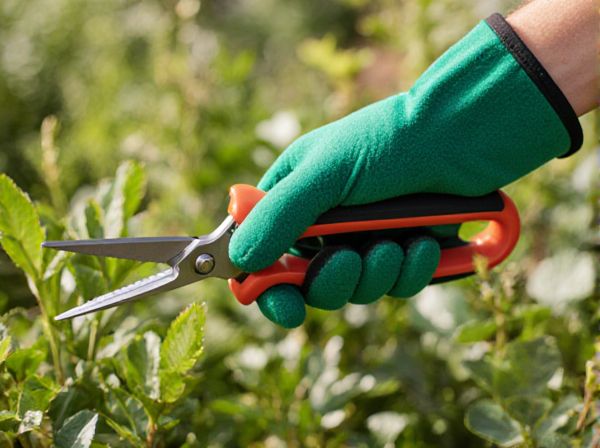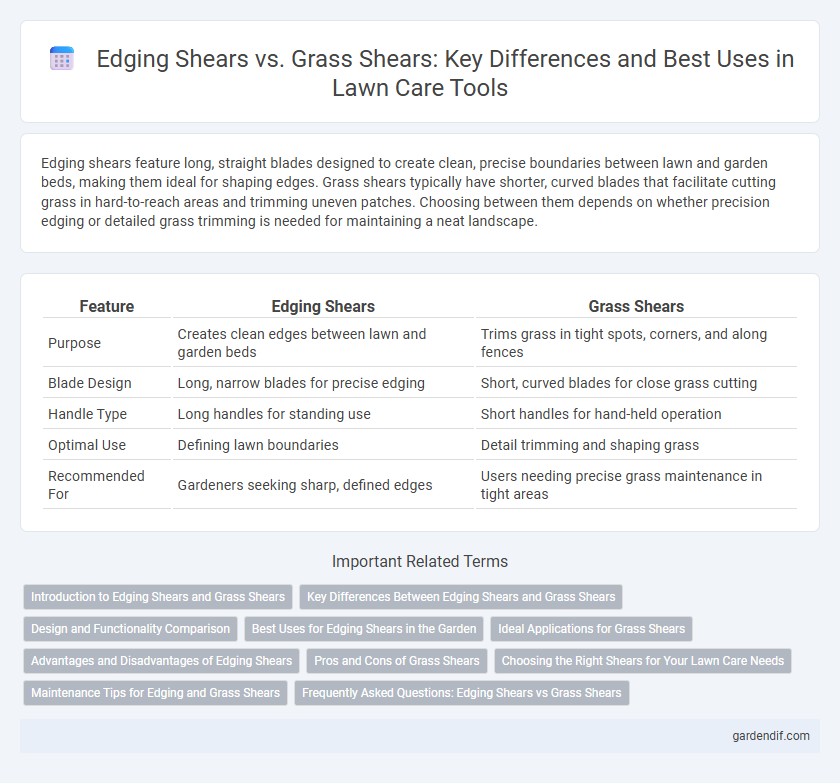
Edging shears vs Grass shears Illustration
Edging shears feature long, straight blades designed to create clean, precise boundaries between lawn and garden beds, making them ideal for shaping edges. Grass shears typically have shorter, curved blades that facilitate cutting grass in hard-to-reach areas and trimming uneven patches. Choosing between them depends on whether precision edging or detailed grass trimming is needed for maintaining a neat landscape.
Table of Comparison
| Feature | Edging Shears | Grass Shears |
|---|---|---|
| Purpose | Creates clean edges between lawn and garden beds | Trims grass in tight spots, corners, and along fences |
| Blade Design | Long, narrow blades for precise edging | Short, curved blades for close grass cutting |
| Handle Type | Long handles for standing use | Short handles for hand-held operation |
| Optimal Use | Defining lawn boundaries | Detail trimming and shaping grass |
| Recommended For | Gardeners seeking sharp, defined edges | Users needing precise grass maintenance in tight areas |
Introduction to Edging Shears and Grass Shears
Edging shears feature long, straight blades designed for precise trimming along garden beds, pathways, and driveways, providing clean, defined edges. Grass shears, in contrast, have shorter, often curved blades tailored for trimming grass in hard-to-reach areas such as borders, around trees, and near fences. Both tools are essential for lawn maintenance but serve different purposes based on blade design and cutting precision.
Key Differences Between Edging Shears and Grass Shears
Edging shears feature long handles and angled blades designed specifically for creating clean, precise lawn edges along sidewalks and flower beds. Grass shears have shorter handles and straight blades optimized for trimming hard-to-reach grass areas and small patches where a lawnmower can't reach. The key difference lies in their blade shape and intended use: edging shears produce sharp, defined borders while grass shears focus on detailed trimming and light cutting.
Design and Functionality Comparison
Edging shears feature longer, straight blades designed for precise cutting along sidewalks, driveways, and garden beds, allowing for sharp, clean edges. Grass shears typically have shorter, often curved blades optimized for trimming patches of overgrown grass and hard-to-reach lawn areas, providing maneuverability and control. The design difference significantly impacts functionality: edging shears excel at defining borders, while grass shears are ideal for fine-detail trimming and shaping irregular lawn spots.
Best Uses for Edging Shears in the Garden
Edging shears are ideal for creating clean, precise borders along garden beds and pathways, offering superior control for shaping lawn edges and trimming thick grass or weeds. Their long handles and sharp blades enable gardeners to reach tight spots and maintain neat garden lines without damaging plants. Unlike grass shears, which are better suited for general lawn trimming, edging shears excel in defining and enhancing garden aesthetics with professional precision.
Ideal Applications for Grass Shears
Grass shears excel in trimming grass around garden beds, pathways, and other hard-to-reach areas where lawnmowers and edging shears cannot easily access. Their long handles and scissor-like blades provide precision for maintaining clean lines and tidying up small patches of grass. Ideal applications include shaping grass borders and detailing around trees, flower pots, and fences.
Advantages and Disadvantages of Edging Shears
Edging shears offer precise control for trimming lawn edges, allowing clean and sharp boundaries that enhance garden aesthetics, but they require manual effort and may be time-consuming for large areas. These shears are typically lighter and easier to maneuver compared to grass shears, making them ideal for detailed work around flower beds and pathways. However, their limited cutting width and the need for frequent sharpening can reduce efficiency on denser or tougher grass patches.
Pros and Cons of Grass Shears
Grass shears offer precise control for trimming grass in tight spots and along edges, making them ideal for detailed lawn maintenance. Their lightweight design and maneuverability allow users to reach areas that lawnmowers or edging shears cannot, but they require more manual effort and time to cover large areas effectively. However, grass shears lack the power and versatility of edging shears, limiting their use mainly to small-scale or touch-up tasks.
Choosing the Right Shears for Your Lawn Care Needs
Edging shears provide precise control for shaping flower beds and creating clean borders, while grass shears are designed to trim grass in hard-to-reach spots. Selecting the right shears depends on the specific lawn care task: use edging shears for defining edges and grass shears for detailed grass trimming. Consider blade size and handle length to ensure comfort and effectiveness during prolonged use.
Maintenance Tips for Edging and Grass Shears
Regularly clean blades of edging and grass shears with a damp cloth to prevent sap buildup and rust. Sharpen the blades using a sharpening stone or file to maintain precise cutting edges and ensure efficient trimming. Lubricate the pivot points with light machine oil to reduce friction and prolong tool lifespan.
Frequently Asked Questions: Edging Shears vs Grass Shears
Edging shears feature long, straight blades designed for precise cutting along sidewalks and garden beds, while grass shears have shorter, often curved blades suited for trimming uneven grass in hard-to-reach areas. Edging shears provide clean, crisp edges for professional-looking landscapes, whereas grass shears offer versatility for detailed trimming around flowerpots and fences. Users commonly ask about the differences in blade design, maneuverability, and ideal use cases for edging shears versus grass shears when selecting the right garden tool.
Edging shears vs Grass shears Infographic

 gardendif.com
gardendif.com